seats CHEVROLET EXPRESS 1996 1.G Owners Manual
[x] Cancel search | Manufacturer: CHEVROLET, Model Year: 1996, Model line: EXPRESS, Model: CHEVROLET EXPRESS 1996 1.GPages: 376, PDF Size: 18.83 MB
Page 7 of 376
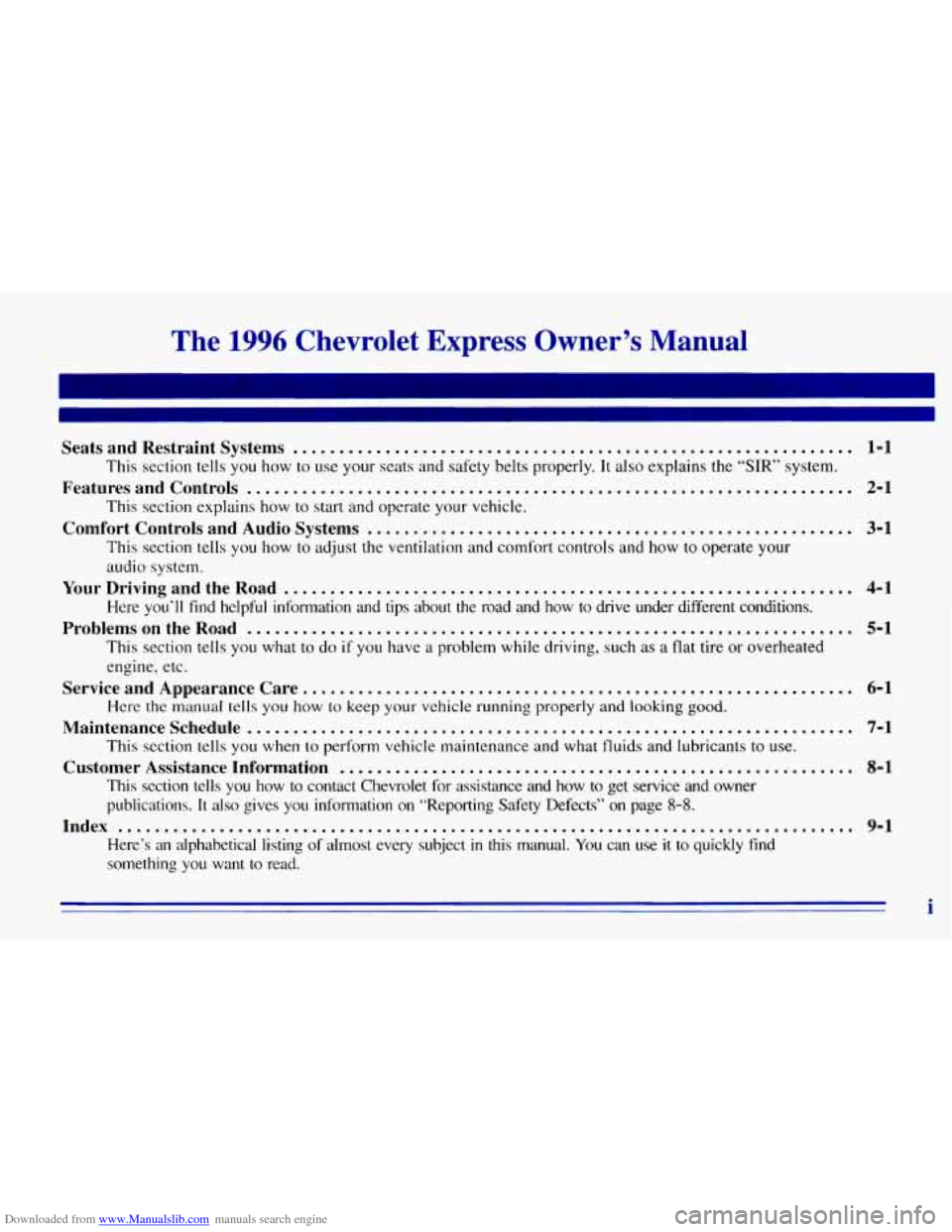
Downloaded from www.Manualslib.com manuals search engine The 1996 Chevrolet Express Owner’s Manual
Seats and Restraint Systems ............................................................. 1-1
This section tells you how to use your seats and safety belts properly. It also explains the “SIR’ system.
FeaturesandControls .................................................................. 2-1
This section explains how to start and operate your vehicle.
This section tells
you how to adjust the ventilation and comfort controls and how to operate your
audio system.
Here you’ll find helpful information and tips about
the road and how to drive under different conditions.
This section
tells you what to do if you have a problem while driving, such as a flat tire or overheated
engine, etc.
Here the manual
tells you how to keep your vehicle running properly and looking good.
This section tells
you when to perform vehicle maintenance and what fluids and lubricants to use.
This section
tells you how to contact Chevrolet for assistance and how to get service and owner
publications.
It also gives you information on “Reporting Safety Defects” on page 8-8.
Here’s an alphabetical listing of almost every subject in this manual. You can use it to quickly find
something you want to read.
Comfort Controls and Audio Systems ..................................................... 3-1
YourDrivingandtheRoad .............................................................. 4-1
ProblemsontheRoad .................................................................. 5-1
Service and Appearance Care ............................................................ 6-1
Maintenanceschedule .................................................................. 7-1
Customer Assistance Information ........................................................ 8-1
Index ........................................................................\
........ 9-1
i
Page 13 of 376
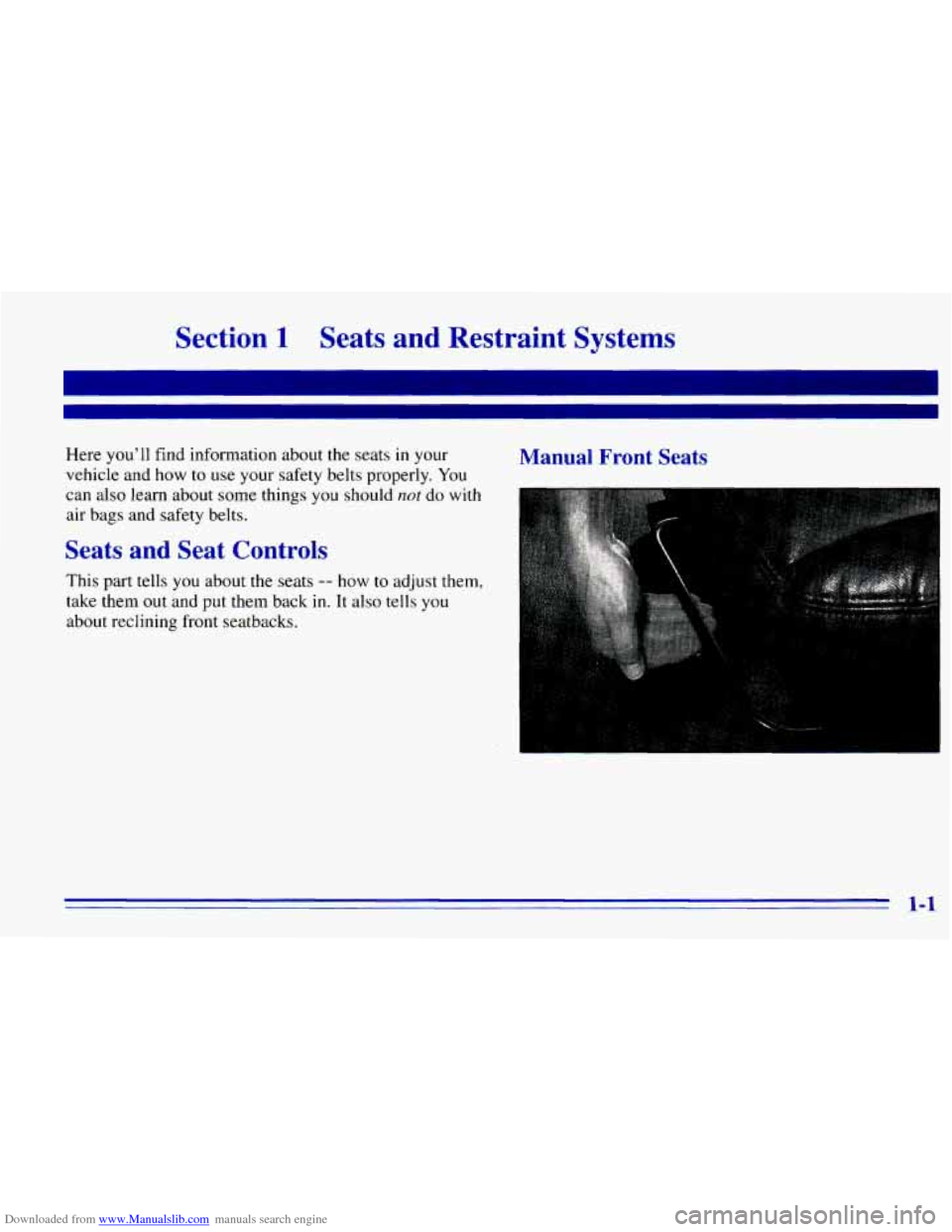
Downloaded from www.Manualslib.com manuals search engine Section 1 Seats and Restraint Systems
Here you'll find information about the seats in your
vehicle and how to use your safety belts properly. You
can also learn about some things you should
nut do with
air bags and safety belts.
Seats and Seat Controls
This part tells you about the seats -- how to adjust them,
take them out and
put them back in. It also tells you
about reclining front seatbacks.
Manual Front Seats
1-1
Page 14 of 376
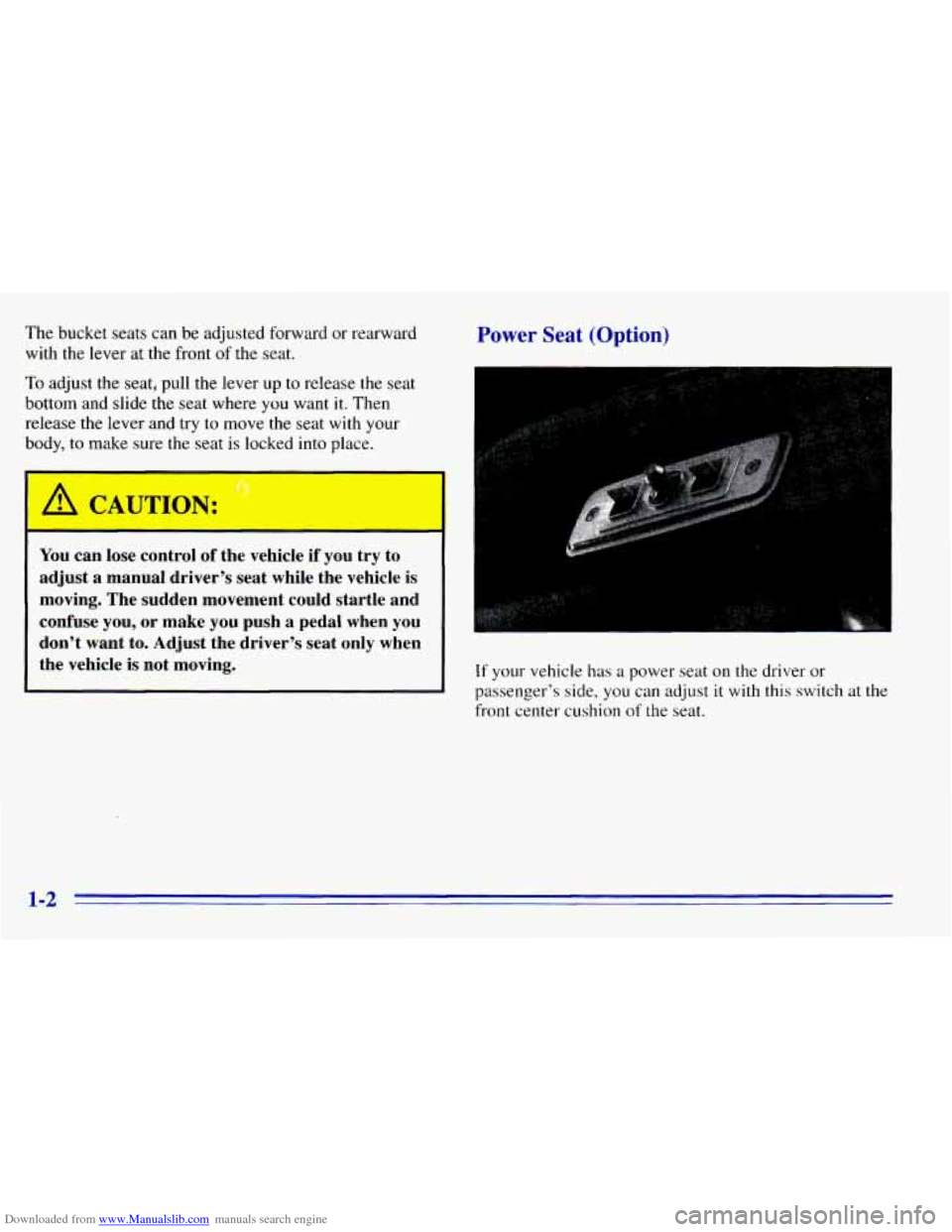
Downloaded from www.Manualslib.com manuals search engine The bucket seats can be adjusted forward or rearward
with the lever at the front
of the seat.
To adjust the seat, pull the lever up to release the seat
bottom and slide the seat where
you want it. Then
release the lever and try to move the seat with
your
body, to make sure the seat is locked into place.
’
A CAUTION:
You can lose control of the vehicle if you try to
adjust a manual driver’s seat while the vehicle is
moving. The sudden movement could startle and
confuse
you, or make you push a pedal when you
don’t want to. Adjust the driver’s seat only when
the vehicle
is not moving.
Power Seat (Option)
I
I
If your vehicle has a power seat on the driver or
passenger’s side, you
can adjust it with this switch at the
front center cushion
of the seat.
1-2
Page 17 of 376
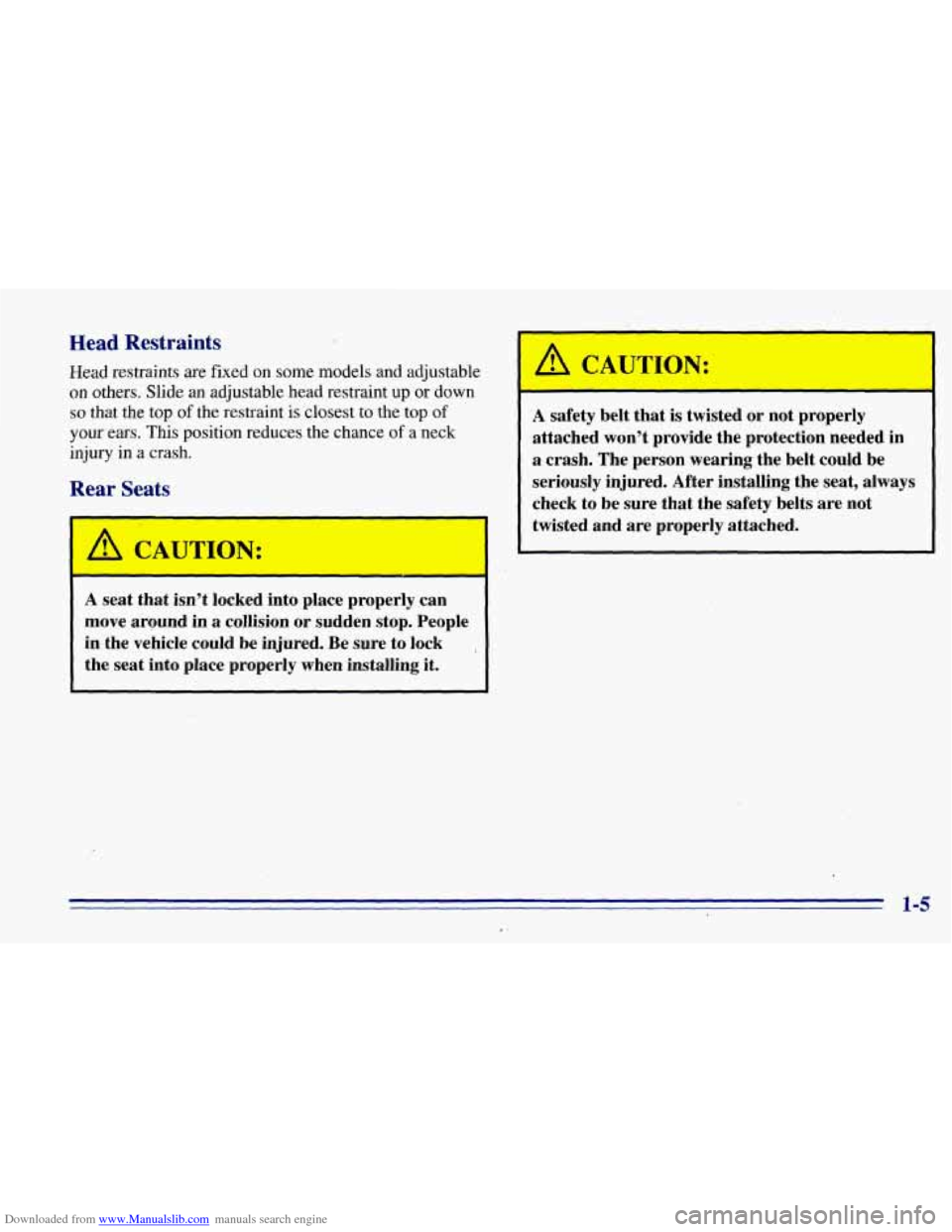
Downloaded from www.Manualslib.com manuals search engine Head Restraints
Head restraints are fixed OB some models and adjustable
on others. Slide
an adjustable head restraint up or down
so that the top of the restraint is closest to the top of
your ears. This position reduces the chance of a neck
injury in a crash.
Rear Seats
' A CAUTION:
rn I
A seat that isn't locked into place properly can
move around in a collision or sudden stop. People
in the vehicle could be injured. Be sure to lock
,
the seat into place properly when installing it.
I A CAUTION:
A safety belt that is twisted or not properly
attached won't provide the protection needed in
1 a crash. The person wearing the belt could be
i seriously injured. After installing the seat, always
i check to be sure that the safety belts are not
' twisted and are'properly attached.
-- ~~ i
1-5
..
Page 25 of 376
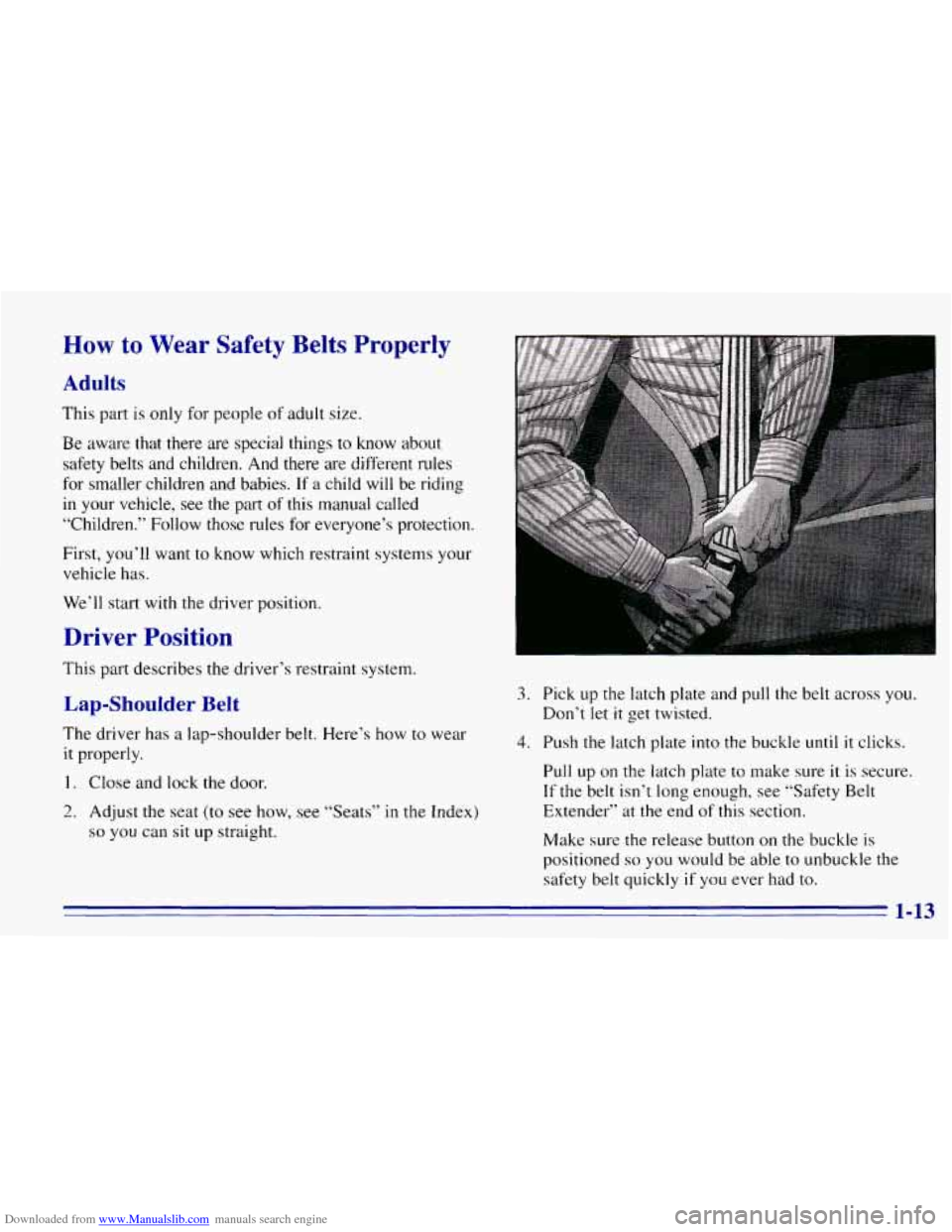
Downloaded from www.Manualslib.com manuals search engine How to Wear Safety Belts Properly
Adults
This part is only for people of adult size.
Be aware that there are special things to
know about
safety belts and children. And there are different
rules
for smaller children and babies. If a child will be riding
in your vehicle, see the part of this manual called
“Children.” Follow those rules for everyone’s protection.
First, you’ll want to know which restraint systems your
vehicle has.
We’ll start with the driver position.
Driver Position
This part describes the driver’s restraint system.
Lap-Shoulder Belt
The driver has a lap-shoulder belt. Here’s how to wear
it properly.
1. Close and lock the door.
2. Adjust the seat (to see how, see “Seats” in the Index)
so you can sit up straight.
3.
4.
Pick up the latch plate and pull the belt across you.
Don’t let it get twisted.
Push
the latch plate into the buckle until it clicks.
Pull up
on the latch plate to make sure it is secure.
If the belt isn’t long enough, see “Safety Belt
Extender” at the end
of this section.
Make sure the release button
on the buckle is
positioned
so you would be able to unbuckle the
safety belt quickly
if you ever had to.
1-13
Page 45 of 376
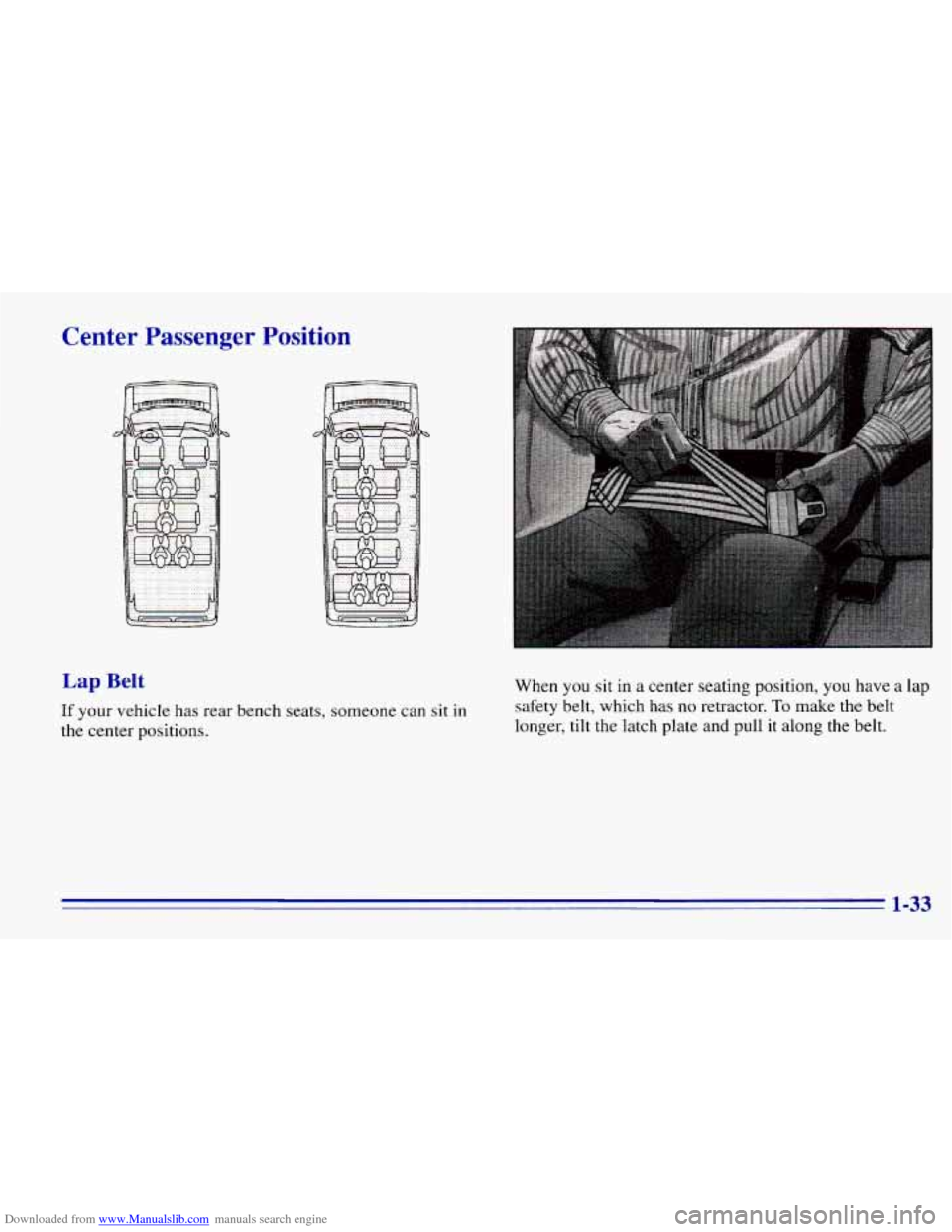
Downloaded from www.Manualslib.com manuals search engine Center Passenger Position
Lap Belt
If your vehicle has rear bench seats, someone can sit in
the center positions. When
you sit
in a center seating position, you have a lap
safety belt, which has no retractor. To make the belt
longer, tilt the latch plate and
pull it along the belt.
1-33
Page 55 of 376
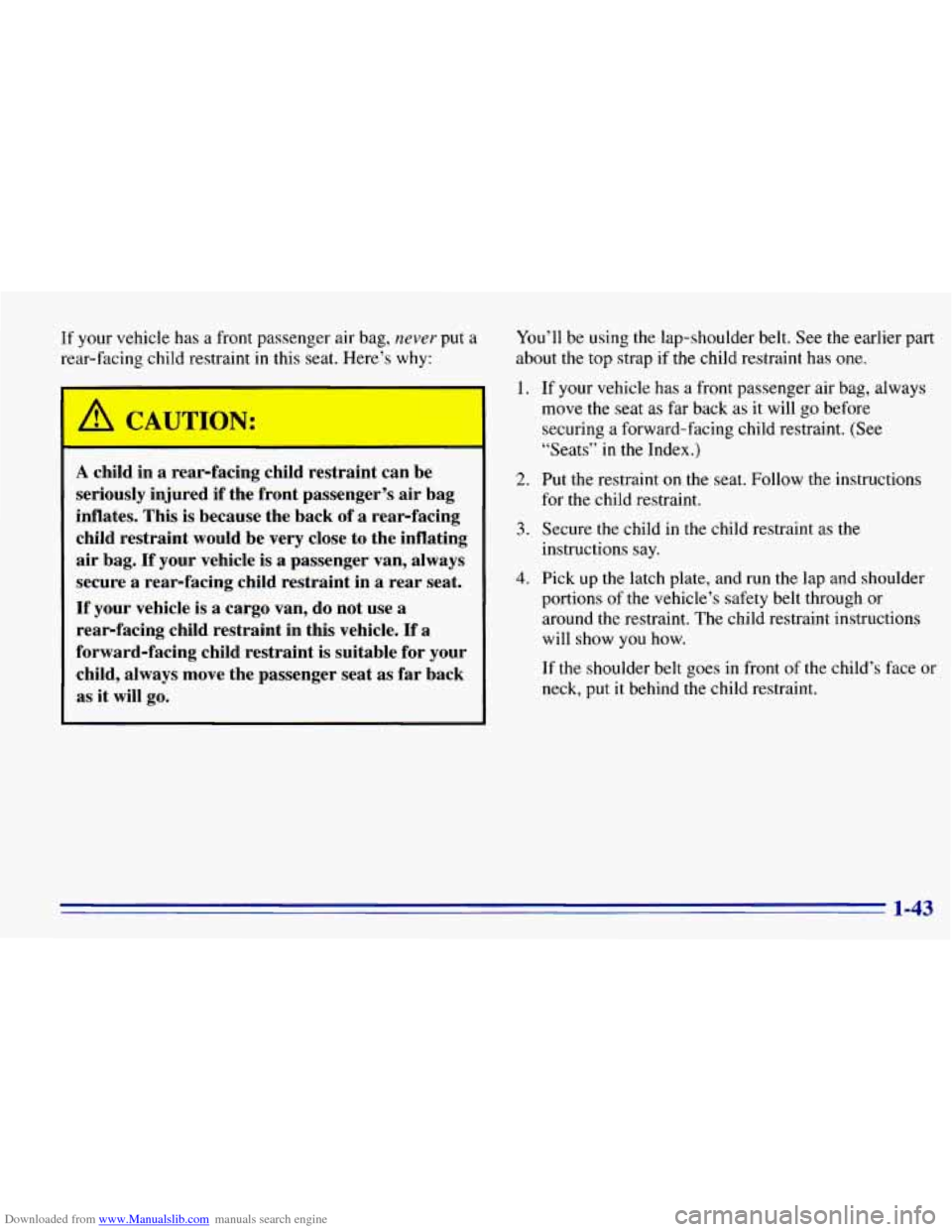
Downloaded from www.Manualslib.com manuals search engine If your vehicle has a front passenger air bag, n.ever put a
rear-facing child restraint
in this seat. Here’s why:
I A CAUTION:
-
A child in a rear-facing child restraint can be
seriously injured
if the front passenger’s air bag
inflates. This
is because the back of a rear-facing
child restraint would be very close to the inflating
air bag.
If your vehicle is a passenger van, always
secure a rear-facing child restraint in a rear seat.
If your vehicle is a cargo van, do not use a
rear-facing child restraint in this vehicle. If a
forward-facing child restraint
is suitable for your
child, always move the passenger seat
as far back
as
it will go.
You’ll be using the lap-shoulder belt. See the earlier part
about
the top strap if the child restraint has one.
1. If your vehicle has a front passenger air bag, always
move the seat as far back as it will go before
securing a forward-facing child restraint. (See
“Seats”
in the Index.)
2. Put the restraint on the seat. Follow the instructions
for the child restraint.
3. Secure the child in the child restraint as the
instructions say.
4. Pick up the latch plate, and run the lap and shoulder
portions of the vehicle’s safety belt through or
around the restraint. The child restraint instructions
will show
you how.
If the shoulder belt goes
in front of the child’s face or
neck, put it behind the child restraint.
1-43
Page 128 of 376
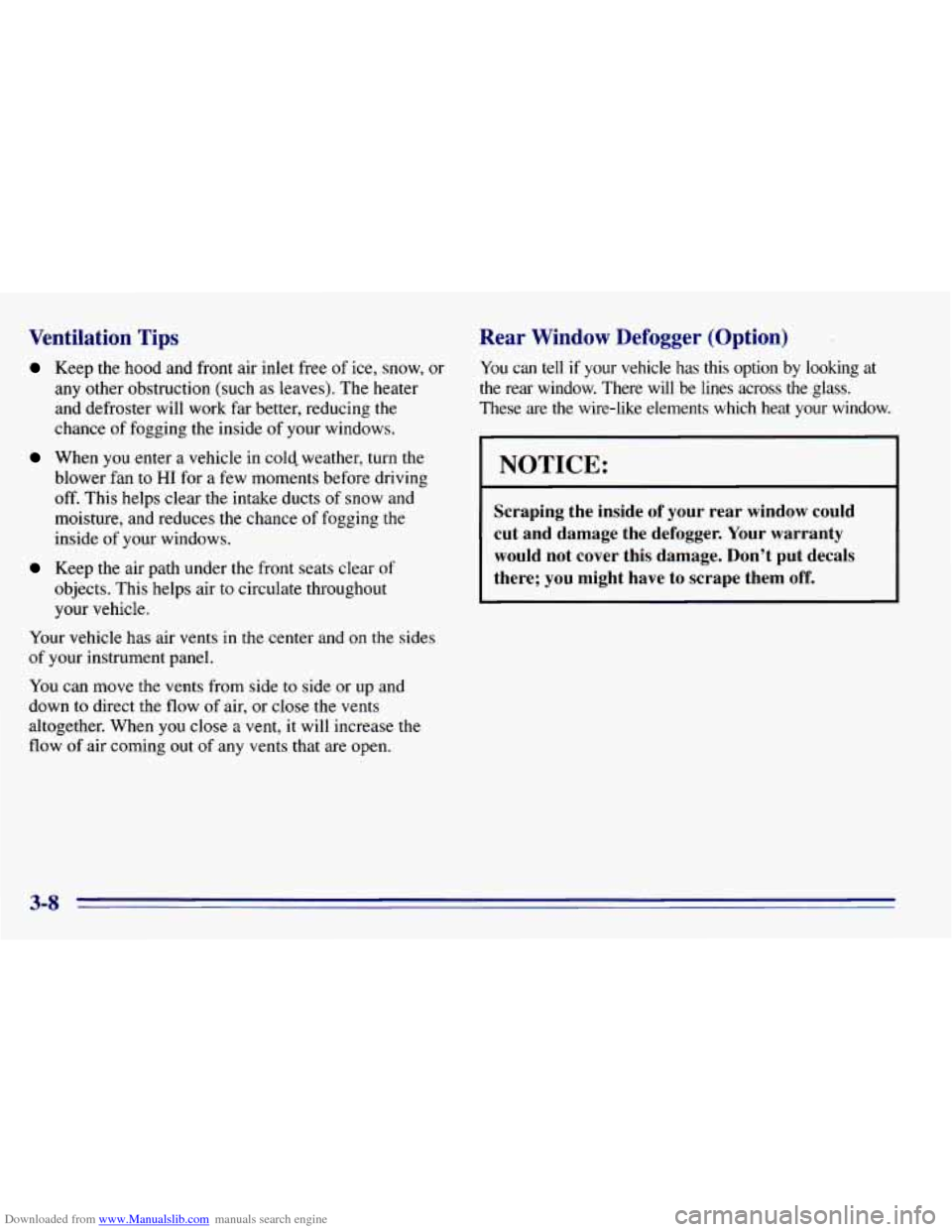
Downloaded from www.Manualslib.com manuals search engine Ventilation Tips
Keep the hood and front air inlet free of ice, snow, or
any other obstruction (such as leaves). The heater
and defroster will work far better, reducing the
chance of fogging the inside
of your windows.
When you enter a vehicle in cold weather, turn the
blower fan to HI for a few moments before driving
off. This helps clear the intake ducts of snow and
moisture, and reduces the chance
of fogging the
inside
of your windows.
Keep the air path under the front seats clear of
objects. This helps air to circulate throughout
your vehicle.
Your vehicle has air vents in the center and on the sides
of your instrument panel.
You can move the vents from side
to side or up and
down to direct the flow
of air, or close the vents
altogether. When
you close a vent, it will increase the
flow of air coming out of any vents that are open.
Rear Window Defogger (Option)
You can tell if your vehicle has this option by looking at
the rear window. There will be lines across the glass.
These are the wire-like elements which heat your window.
NOTICE:
Scraping the inside of your rear window could
cut and damage the defogger. Your warranty
would not cover this damage. Don’t put decals
there; you might have to scrape them off.
3-8
Page 179 of 376
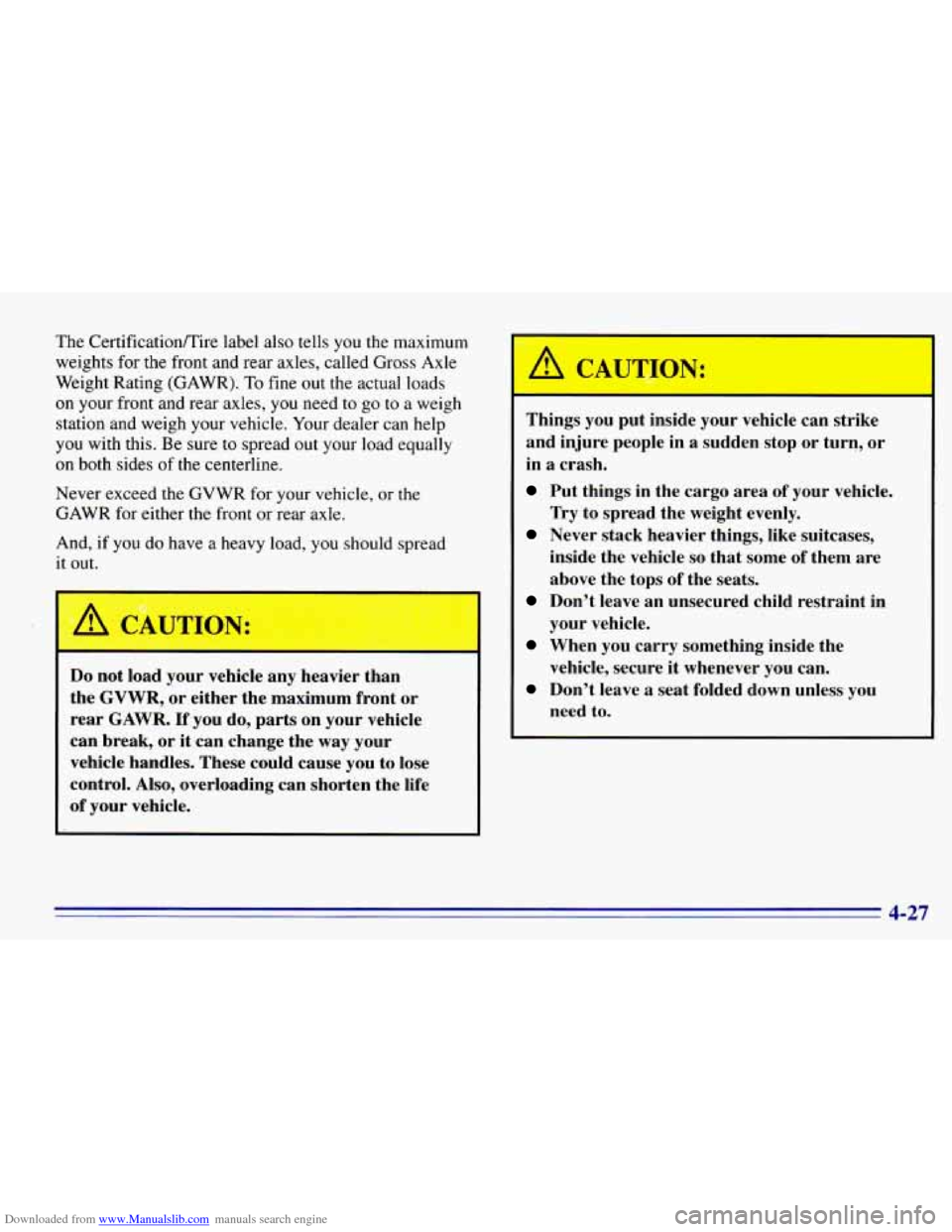
Downloaded from www.Manualslib.com manuals search engine The Certification/Tire label also tells you the maximum
weights for the front and rear axles, called Gross Axle
Weight Rating (GAWR).
To fine out the actual loads
on your front and rear axles, you need to go to a weigh
station and weigh your vehicle. Your dealer can help
you with this. Be sure to spread out your load equally
on both sides
of the centerline.
Never exceed the GVWR
for your vehicle, or the
GAWR for either the front or rear axle.
And,
if you do have a heavy load, you should spread
it out.
Do not load your vehicle any heavier than
the
GVWR, or either the maximum front or
rear
GAWR. If you do, parts on your vehicle
can break, or it can change the
way your
vehicle handles. These could cause you to lose
control.
Also, overloading can shorten the life
of your vehicle.
A CAUTION:
Things you put inside your vehicle can strike
and injure people
in a sudden stop or turn, or
in
a crash.
Put things in the cargo area of your vehicle.
Try to spread the weight evenly.
1 Never stack heavier things, like suitcases,
~ inside the vehicle so that some of them are
above the tops of the seats.
Don’t leave an unsecured child restraint in
your vehicle.
When you carry something inside the
vehicle, secure it whenever you can.
Don’t leave a seat folded down unless you
need to.
I
4-27